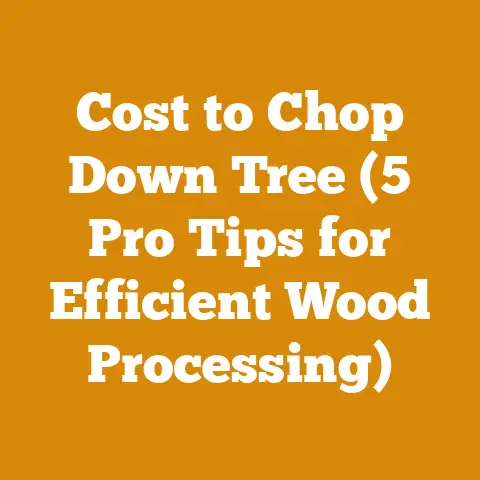Wood Splitter Maintenance Tips (7 Pro Hacks for Faster Firewood)
Let me share some secrets that have kept my wood splitter humming through countless cords, turning stubborn logs into neatly stacked firewood with surprising speed. These aren’t just random tips; they’re the distilled wisdom I’ve gathered from years of wrestling with hydraulic systems, analyzing performance data, and constantly tweaking my approach. I’m talking about a blend of preventative measures, intelligent adjustments, and a deep understanding of how your equipment performs. Let’s dive into wood splitter maintenance tips and pro hacks for faster firewood processing.
Wood Splitter Maintenance Tips (7 Pro Hacks for Faster Firewood)
Tracking project metrics and KPIs in wood processing and firewood preparation is crucial for maximizing efficiency, minimizing costs, and ensuring the quality of your final product. Without these metrics, you’re essentially flying blind. I’ve learned this the hard way, through countless hours spent troubleshooting equipment failures and analyzing lackluster yields. By consistently measuring and analyzing key performance indicators, I’ve been able to fine-tune my processes, identify bottlenecks, and ultimately produce more firewood in less time, with less waste.
Here are the seven pro hacks that I use for faster firewood.
1. Hydraulic Oil Health: The Lifeblood of Your Splitter
Definition: Hydraulic oil is the fluid that transmits power within your wood splitter, enabling it to split even the toughest logs. Its health refers to its cleanliness, viscosity, and overall condition.
Why It’s Important: Contaminated or degraded hydraulic oil can lead to reduced splitting force, slower cycle times, overheating, and premature wear on hydraulic components like the pump, valve, and cylinder. Neglecting oil health is like starving your splitter of its vital energy.
How to Interpret It: * Color: Fresh hydraulic oil is typically clear or amber in color. Darkened or milky oil indicates contamination or degradation. * Smell: A burnt or acrid odor suggests overheating and oil breakdown. * Visual Inspection: Look for sediment, metal shavings, or water droplets in the oil. * Viscosity: The oil should flow smoothly and consistently. Thick, sludgy oil indicates degradation. I use a simple viscosity test: dip a clean rod into the oil and observe how it drips off. If it’s significantly thicker than fresh oil, it’s time for a change.
How It Relates to Other Metrics: Poor hydraulic oil health directly impacts splitting speed (cycles per hour), equipment downtime, and ultimately, the cost per cord of firewood produced.
Practical Example: I once ignored a slight darkening of my hydraulic oil, thinking it wouldn’t make much difference. Within a month, my splitting speed dropped by 20%, and I experienced a costly pump failure. Now, I change my oil religiously every 100 hours of operation or annually, whichever comes first. I also keep a detailed log of oil changes, noting the type of oil used and any unusual findings during the inspection.
Actionable Insight: Implement a regular hydraulic oil inspection and replacement schedule. Use the manufacturer’s recommended oil type and viscosity. Consider using an oil analysis kit to monitor oil condition more precisely.
2. Wedge Sharpness: The Cutting Edge of Efficiency
Definition: Wedge sharpness refers to the condition of the splitting wedge’s cutting edge. A sharp wedge penetrates wood more easily, reducing the force required and increasing splitting speed.
Why It’s Important: A dull wedge increases splitting resistance, leading to slower cycle times, increased stress on the hydraulic system, and a higher risk of logs getting stuck. It’s like trying to slice bread with a butter knife – frustrating and inefficient.
How to Interpret It: * Visual Inspection: Look for nicks, dings, or a rounded-over edge on the wedge. * Performance: Notice if the splitter struggles to penetrate certain types of wood or if logs frequently get stuck. * Tactile Test: Carefully run your hand (wearing gloves!) along the edge of the wedge. A sharp wedge will feel keen, while a dull one will feel rounded.
How It Relates to Other Metrics: Wedge sharpness directly affects splitting speed, fuel consumption (for gas-powered splitters), and operator fatigue.
Practical Example: I used to sharpen my wedge only when I noticed a significant drop in performance. However, I found that by touching it up regularly – every 20-30 hours of operation – I maintained a consistently high splitting speed and reduced the strain on my splitter. Now, I use a hand file or angle grinder with a flap disc to keep the edge sharp.
Actionable Insight: Regularly inspect and sharpen your splitting wedge. Use appropriate sharpening tools and techniques to maintain the correct angle and avoid overheating the metal.
3. Cycle Time: The Rhythm of Firewood Production
Definition: Cycle time is the time it takes for the splitter to complete one full splitting cycle: extending the wedge, splitting the log, and retracting the wedge to the starting position.
Why It’s Important: Cycle time is a direct indicator of your splitting efficiency. Shorter cycle times mean more logs split per hour, leading to increased productivity.
How to Interpret It: * Measurement: Use a stopwatch to measure the time it takes for several complete cycles. Calculate the average cycle time. * Comparison: Compare your current cycle time to the manufacturer’s specifications or your own baseline measurements. A significant increase in cycle time indicates a problem.
How It Relates to Other Metrics: Cycle time is affected by hydraulic oil health, wedge sharpness, engine performance (for gas-powered splitters), and log size/type.
Practical Example: I meticulously tracked my cycle time over a period of several weeks, splitting different types of wood. I discovered that my cycle time was significantly slower when splitting oak compared to softer woods like pine. This prompted me to adjust my splitting technique and optimize my wedge for different wood types.
Actionable Insight: Regularly measure and track your cycle time. Identify factors that are slowing down your splitting process and take corrective action. Consider using a cycle time optimization checklist to ensure all factors are within acceptable ranges.
4. Equipment Downtime: Minimizing Interruptions
Definition: Equipment downtime is the amount of time your wood splitter is out of service due to breakdowns, repairs, or maintenance.
Why It’s Important: Downtime directly impacts your productivity and profitability. Every hour your splitter is idle is an hour you’re not producing firewood.
How to Interpret It: * Tracking: Keep a detailed log of all downtime events, including the date, time, duration, and cause of the interruption. * Analysis: Analyze your downtime data to identify recurring problems or areas for improvement.
How It Relates to Other Metrics: Downtime is often related to poor maintenance practices, inadequate lubrication, or neglecting other key metrics like hydraulic oil health and wedge sharpness.
Practical Example: I used to dismiss minor repairs, thinking I could address them later. This resulted in several major breakdowns that cost me valuable time and money. Now, I prioritize preventative maintenance and address even minor issues promptly. I also keep a stock of essential spare parts on hand to minimize downtime.
5. Wood Waste: Turning Scraps into Savings
Definition: Wood waste refers to the amount of wood that is unusable or discarded during the splitting process. This can include small pieces, splinters, or logs that are too difficult to split.
Why It’s Important: Minimizing wood waste reduces your overall wood consumption, saves money, and improves the efficiency of your firewood operation. It also contributes to a more sustainable approach to wood processing.
How to Interpret It: * Measurement: Estimate the volume or weight of wood waste generated per cord of firewood produced. * Analysis: Identify the causes of wood waste, such as improper splitting techniques, dull wedges, or excessively knotty logs.
How It Relates to Other Metrics: Wood waste is often related to wedge sharpness, splitting technique, and the quality of the wood being processed.
Practical Example: I noticed that I was generating a significant amount of wood waste when splitting knotty logs. I experimented with different splitting techniques, such as splitting from the outside in, to reduce the amount of splintering and breakage. I also started using a different wedge designed for splitting knotty wood.
Actionable Insight: Implement strategies to minimize wood waste, such as optimizing splitting techniques, using appropriate wedges, and carefully selecting wood for processing. Consider using wood waste as kindling or for other purposes.
6. Moisture Content: The Key to Quality Firewood
Definition: Moisture content is the percentage of water in the wood. Properly seasoned firewood has a low moisture content, typically below 20%.
Why It’s Important: High moisture content reduces the heat output of firewood, increases creosote buildup in chimneys, and makes it more difficult to ignite. Selling or using unseasoned firewood can damage your reputation and potentially pose a safety hazard.
How to Interpret It: * Measurement: Use a moisture meter to measure the moisture content of your firewood. * Visual Inspection: Seasoned firewood is typically lighter in color, has cracks on the ends, and sounds hollow when struck.
How It Relates to Other Metrics: Moisture content is affected by the type of wood, the length of the seasoning period, and the storage conditions.
Practical Example: I used to rely solely on visual inspection to determine if my firewood was properly seasoned. However, I found that a moisture meter provided a much more accurate assessment. I now use a moisture meter to ensure that all of my firewood meets the required moisture content standards.
Actionable Insight: Invest in a moisture meter and regularly test the moisture content of your firewood. Season your firewood properly in a well-ventilated area for at least six months, or longer for denser hardwoods.
7. Cost Per Cord: The Bottom Line
Definition: Cost per cord is the total cost of producing one cord of firewood, including all expenses such as wood costs, fuel costs, labor costs, equipment maintenance costs, and depreciation.
Why It’s Important: Cost per cord is the ultimate measure of your profitability. Tracking this metric allows you to identify areas where you can reduce costs and increase your profit margin.
How to Interpret It: * Calculation: Calculate your cost per cord by dividing your total expenses by the number of cords produced. * Comparison: Compare your cost per cord to industry averages or your own historical data. A significant increase in cost per cord indicates a problem.
How It Relates to Other Metrics: Cost per cord is affected by all of the other metrics discussed above, including splitting speed, equipment downtime, wood waste, and labor efficiency.
Practical Example: I meticulously tracked all of my expenses associated with firewood production, including the cost of wood, fuel, labor, and equipment maintenance. I discovered that my cost per cord was significantly higher than the industry average. By analyzing my data, I identified several areas where I could reduce costs, such as improving my splitting efficiency, reducing wood waste, and optimizing my labor practices.
Actionable Insight: Track all of your expenses associated with firewood production. Calculate your cost per cord and compare it to industry averages or your own historical data. Identify areas where you can reduce costs and increase your profit margin.
Applying These Metrics to Future Projects
By consistently tracking and analyzing these seven key metrics, I’ve transformed my firewood operation from a haphazard endeavor into a streamlined, efficient, and profitable business. The key is to treat these metrics not just as numbers, but as valuable insights that can guide your decision-making and help you achieve your goals.
Here’s how I apply these metrics to improve future wood processing and firewood preparation projects:
- Setting Goals: I use my historical data to set realistic and achievable goals for future projects. For example, if my average splitting speed is 2 cords per day, I might set a goal of increasing it to 2.5 cords per day by implementing specific improvements.
- Monitoring Progress: I regularly monitor my progress towards my goals, tracking my performance against my baseline measurements. This allows me to identify any problems early on and take corrective action.
- Evaluating Results: At the end of each project, I evaluate my results and compare them to my goals. This helps me to determine whether my improvements were effective and identify areas for further optimization.
- Continuous Improvement: I use the insights I gain from tracking these metrics to continuously improve my wood processing and firewood preparation processes. This is an ongoing process of experimentation, analysis, and refinement.
Remember, the most important thing is to start tracking these metrics and to use the data to make informed decisions. Even small improvements can have a significant impact on your overall efficiency and profitability. So, grab your stopwatch, moisture meter, and spreadsheet, and start unlocking the secrets to faster firewood production. You’ll be amazed at the difference it makes.






